Game Design Techniques: Mixing
Many popular games use static , that is, immutable maps. For example, the huge world of Skyrim is the same for all players. All buildings, dungeons, people, monsters and objects are always in one place. The popularity of such static cards has a reason: the creators can customize the content to ensure a holistic gameplay throughout the game.

Every item in Skyrim (including this useless bowl next to the steps) is in the same place for all players.
But if the cards do not change, the player can study and memorize them. And remembering what worked in the previous passage, you can simply repeat the same steps in the following. Over time, all the complex strategic decisions made in the game are destroyed and transformed into a puzzle with memorization. For this reason, games with static cards often have the problem of replayability .
Over the years, game designers have come up with many ways to improve the replayability of static games. The Super Metroid card is a complex, winding maze . To pass the game, players must return through the old areas many times in search of a way out of the maze.
')
In most cases, if a player has to go back, he starts to get bored. But in Super Metroid, when returning to the old area, the player often has new features and upgrades that change the way it passes. They can be passed in a different direction (for example, downwards, not upwards), changing the types of difficulties encountered.
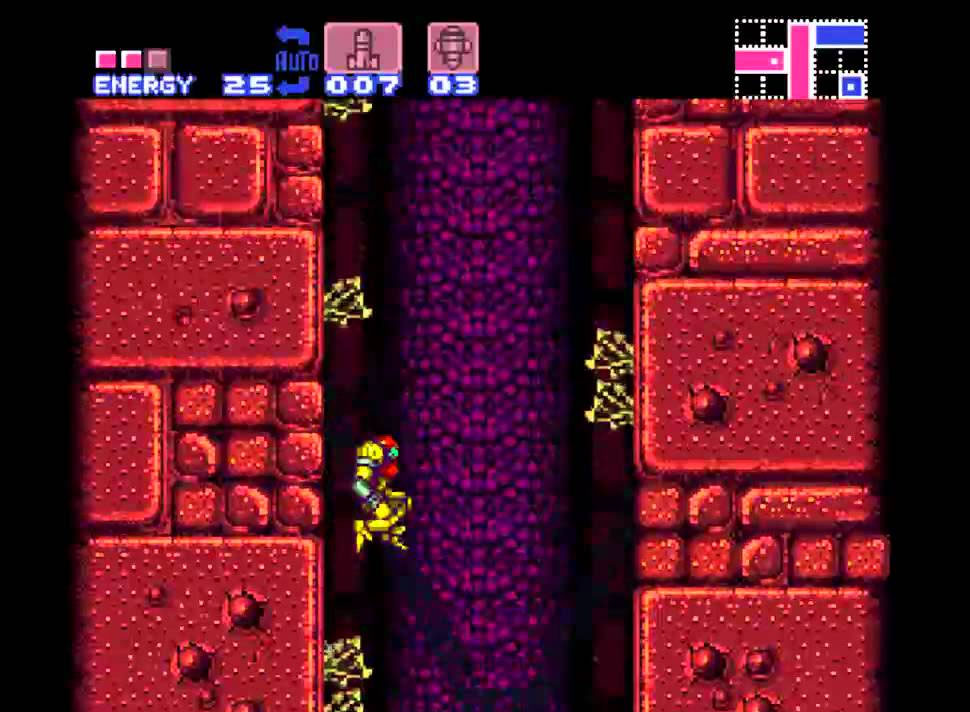
Jumping down is one thing. Climbing up is completely different.
Hollow knight - a new look at maze games with fresh ideas. In it periodically there are points of rapid movement, making long journeys more practical. In addition, updating the card is possible only after sitting on a bench. This means that you cannot rely on the map when you first explore the area.
A serious lack of labyrinths is that they still remain puzzles , that is, they have a permanent solution that can be found. After going through the maze, it is usually rare to want to play the game again. It may take several years to forget the map well and make the game seem fresh again.
In open world games, a different approach is used. They are static but non-linear . The map is still the same for all players, but they can choose their own way of passing it. By providing a large number of places studied, it is possible to provide a gameplay that is unique for each player.
Zelda copes well with this task : Breath Of The Wild . After completing the tutorial, the player can visit almost any point on the map. Some areas are softly limited by the complexity and weather conditions, but experienced players can handle it. There are cities and villages in the world that guide the player to the most important content, but it is not necessary to visit large parts of the game. Most players do not find even a small fraction of all 120 Sheik shrines, and this is only one aspect of the game’s content.

I could not get to all these blue dots! I managed to visit hardly a third!
But to create such games requires a huge amount of labor. Approximately 300 people worked on Zelda for four years, and still in some places it looks a bit unfinished. There are only about a dozen unique types of enemies (except for color variations), and many of the side quests are routine tasks of collecting items.
Those who played in Skyrim , also know how such games are prone to bugs. They have a lot of content that can interact with each other in complex and unexpected ways, which makes rigorous quality testing a very complex process.
Some developers went in a different direction and got rid of all the content, optional for the foundation of the game.
The best example of this approach is Journey . This game lasts hardly more than two hours, but each of its parts is unique and strongly crashes into memory. The plot evokes a wide range of emotions, it has a couple of big surprises and a logical ending.
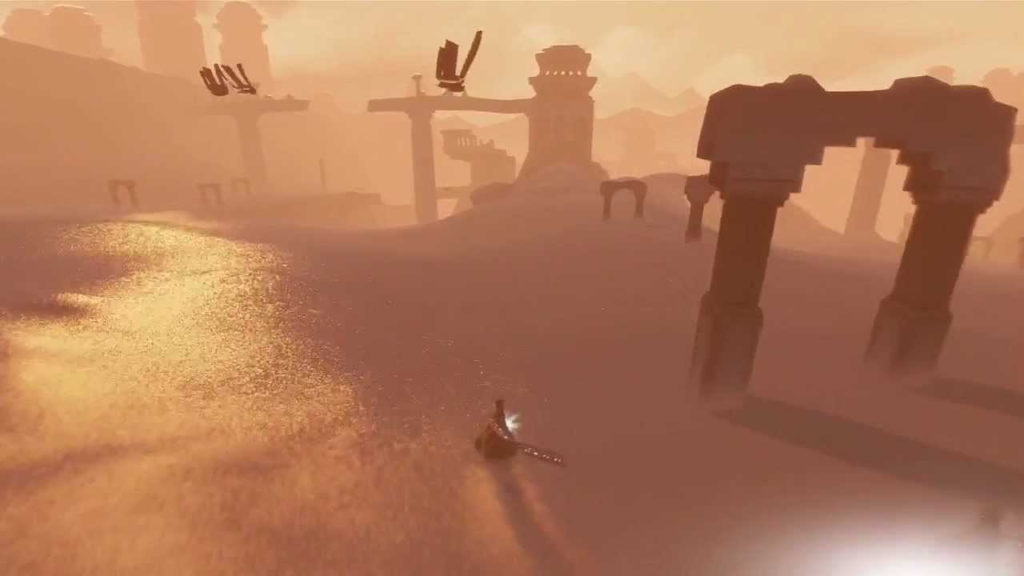
In this part with obstacles, the player only slides down for a few minutes, but the gameplay is so exciting that you do not notice!
Such games do not tend to increase replayability; instead, they carefully approach the plot and try to make the first pass as strong as possible. For some games, this is ideal, but if you create something more gameplay-oriented, then this approach will not suit you.
Much can be achieved on static maps. But I believe that there is also a huge untapped potential in dynamic maps, which change with each new pass.
This idea has been in the air for quite some time. In the 1980 game of Rogue, the player descends into a dynamically created dungeon. Each floor of the dungeon is assembled from randomly located rooms and corridors. The contents of the rooms are also created randomly based on the list of possible floor options. One room is the initial location, and the other is the staircase leading to the next floor. If the player can reach the bottom floor and defeat the boss, he will win.
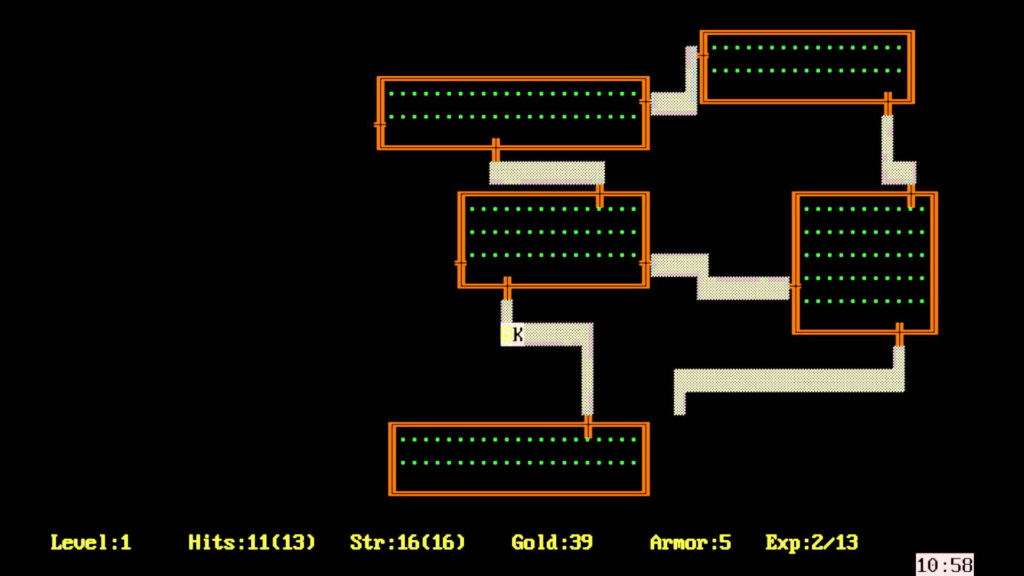
Rogue graphics are a bit outdated.
It is important to note that the dungeon is a combination of constant and changing content. The game always has the same number of floors and each floor has its own set of possible enemies. Without these permanent structures, a player could never predict and learn. The gameplay would be a video game analogue of white noise - a fuzzy and indistinguishable spot.
The point is that interesting dynamic games are not made by chance itself, but by a combination of chance and structure . If there are too many structures, the game becomes predictable and turns into a memory puzzle. But if there is too much randomness, then the game becomes blurred and there is not enough clear complexity and tactics.
Mixing is the simplest and most effective way to maintain a balance between randomness and structure. After mixing the deck of cards, you do not know which of them is on top. However, knowing the types of cards in the deck, you can make reasonable assumptions.
In the modern game Spelunky , inspired by the example of Rogue , mixing is implemented very effectively. Each floor of the dungeon is a permanent 4 × 4 grid of square rooms. These rooms are created by hand, which gives the designer the ability to control their contents. In one room there may be a floor of thorns and several platforms for crossing it. In another room there may be a ladder and a trap with arrows directed at it. Each room is a self-sufficient task that a player can learn and improve in solving it.
All rooms are mixed, so every time a player passes, he sees a unique sequence of fixed tasks. Some elements of the room are also randomized, which adds another level of dynamic structure.
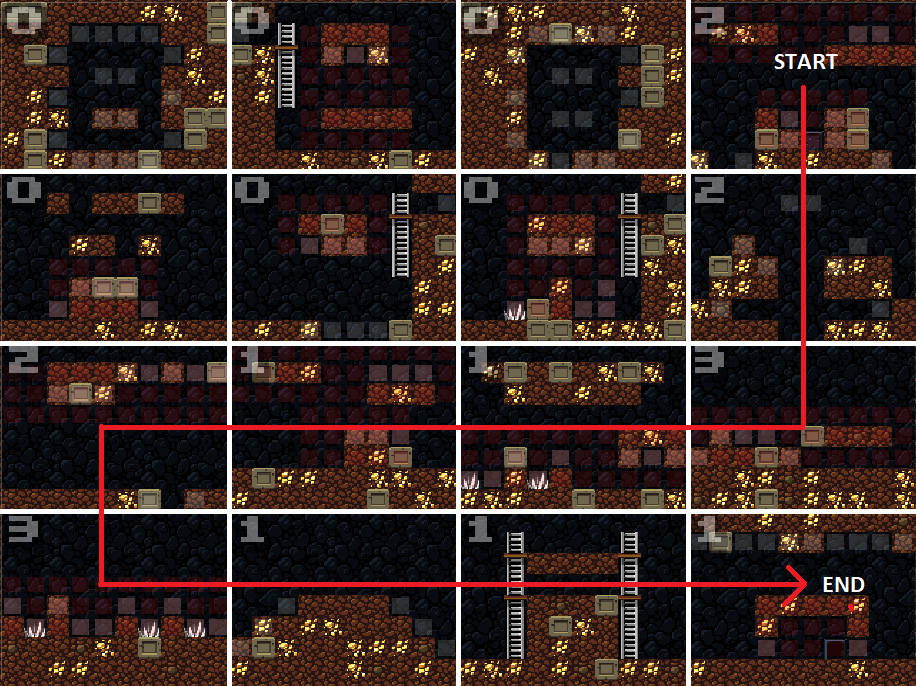
An example of a floor from Spelunky. The red line shows the optimal path for the labyrinth.
Mixing can be used in different games and in various ways. To make the game more dynamic, it is not necessary to copy Rogue or its modern followers.
Pokemon Red uses a static map with dynamically created appointments. Each lawn with grass is the same for each player, but a specific Pokemon that you can stumble upon in this grass is selected by mixing (taken from a randomly mixed list of Pokemon living in this area).
In Hearthstone, there is no map at all in the traditional sense. She has a small static playing field with seven slots for minions on each side. But shuffling the player’s cards adds to each game a large variety of gameplay situations.
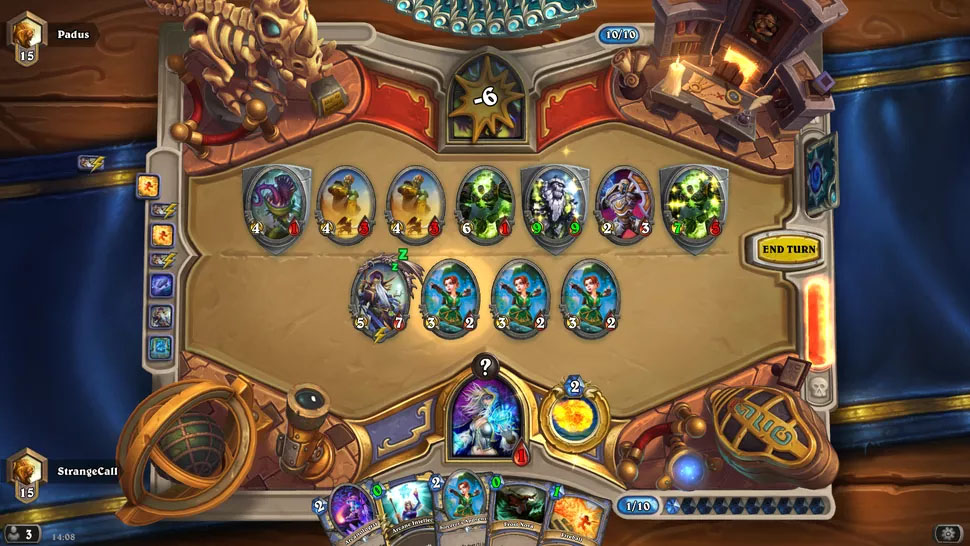
Dynamic matches, but without a map.
The game does not have to be associated with the study of dungeons (and indeed with research) in order to use dynamic structures in it.
It is easy to neglect the importance of a permanent structure in a dynamic world. As a sad example, look at No Man's Sky . This game promised infinite variability ( “every atom is created procedurally” ) and in a sense, the developers kept their promises: the player can explore an almost infinite number of unique planets.
But not all "uniqueness" is equivalent. In Zelda: A Link to the Past , each dungeon had its own set of enemies, traps, schemes, and bosses. These dungeons were very unique. But in No Man's Sky, each planet was only slightly different from the billions of others. The sky could have a different color, and the leaves on the trees - a different shape, but from the point of view of the gameplay, most of these changes did not give any differences. There are about a dozen mechanically unique types of planets (stony planets, frozen planets, planets with jungles, etc.). I think this game would be much better if the developers focused on creating a dozen truly unique planets instead of ten trillion slightly different shades of ten planets.

I have never seen this particular type of goat before. But it's still a cosmic goat.
In my own game, Patch Quest, the map is mostly static. The characteristic features of the landscape, biomes and geological formations such as rocks and rivers are constantly in the same places. Thanks to this, the player can remember the general outlines of the area and create strategies for its passage. But it also allows me to tell stories about the world (a player can be sent to a specific area A to find something for someone living in area B).
But on a small scale, the relief is very mixed. And even if you have previously crossed a certain part of the forest, the next time the trees, stones and creatures will be in other places. We can say that the player plans his general route, but improvises , choosing individual steps.
In most Rogue inspired games, the map is recreated every time it passes. However, in Patch Quest, the map is shuffled every time a player reaches a control point. This ensures that the player is always waiting for new obstacles, even if he passes through a previously visited area.
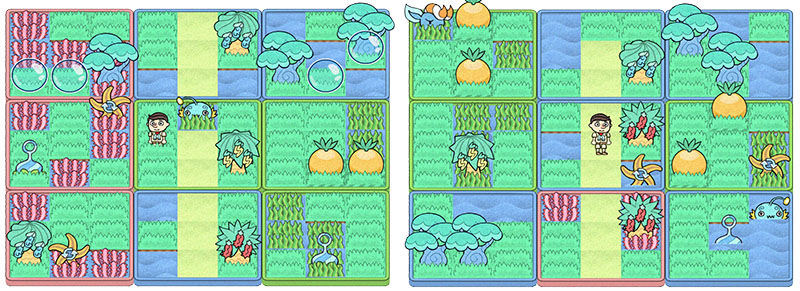
Here you see one Patch Quest location, but after two different mixes. The trail remains in place and the vegetation is similar. But the tactics needed to move east or west vary greatly.
Even a small difference in location can significantly influence a strategy. Patch Quest shows the player a grid of tiles. It may seem small, but in fact more chessboard! And in chess, a single cell can separate victory from defeat.
Patch Quest is much easier than chess (because the player has only one character, not sixteen!). But here I want to emphasize that small variations in the details of the game can significantly affect replayability. It is not necessary to build a fully procedural world. A game can be almost completely static and still greatly benefit from small dynamic elements.
As in Spelunky , the world of Patch Quest is created from a grid of self-sufficient modules. In Spelunky, each room has the size of a chessboard (8 × 8 cells), and each Patch Quest “lawn” is the size of a field for daggers (3 × 3 cells).
By significantly reducing the size of the mosaic, I gave each lawn a clear and unique appearance. On each lawn there is one type of dangerous terrain (below you can see Fever grass, Tonic algae, and Spike grass), one type of creature, and one type of entourage. All these elements from a mechanical point of view are unique, that is, the passage of each lawn requires its own tactics.
The location of each of these elements is also randomized. So even if Sharpotrav, Spinning Star and Glass Bubble are on two lawns, these elements will be located in a different pattern. Some lawns have bonus elements for additional variation, for example, the sand wall on the left (but these elements always refer only to their own lawn and do not cross its boundaries).

Each lawn is a small unique tactical puzzle. But the real advantages are manifested when they are connected to the grid. Now the player not only has to cross one lawn, but also to find a way through many lawns. In addition, some animals can chase him and attack beyond the boundaries of the lawn, which adds to the strategy of variation.
This repeating “patchwork” pattern allowed me to find a balance between randomness and the structure of the game.
Static, manually created content has many advantages (which is why there are so many static games in the world!). But the addition of dynamic elements, even the smallest, has a tremendous effect on replayability. In fact, in order for your game not to turn into a puzzle with memorization, you need not so much randomness! In addition, many players will be more interested in the passage if they know that it is unique.
In this article I covered only some of the ways to create dynamic maps, and I want to push you to experiment and test new ideas. I believe that the tremendous success of such pioneering games like Spelunky and The Binding of Isaac shows that there is an unmet need for games that create duration using dynamic elements.

Every item in Skyrim (including this useless bowl next to the steps) is in the same place for all players.
But if the cards do not change, the player can study and memorize them. And remembering what worked in the previous passage, you can simply repeat the same steps in the following. Over time, all the complex strategic decisions made in the game are destroyed and transformed into a puzzle with memorization. For this reason, games with static cards often have the problem of replayability .
Labyrinths
Over the years, game designers have come up with many ways to improve the replayability of static games. The Super Metroid card is a complex, winding maze . To pass the game, players must return through the old areas many times in search of a way out of the maze.
')
In most cases, if a player has to go back, he starts to get bored. But in Super Metroid, when returning to the old area, the player often has new features and upgrades that change the way it passes. They can be passed in a different direction (for example, downwards, not upwards), changing the types of difficulties encountered.

Jumping down is one thing. Climbing up is completely different.
Hollow knight - a new look at maze games with fresh ideas. In it periodically there are points of rapid movement, making long journeys more practical. In addition, updating the card is possible only after sitting on a bench. This means that you cannot rely on the map when you first explore the area.
A serious lack of labyrinths is that they still remain puzzles , that is, they have a permanent solution that can be found. After going through the maze, it is usually rare to want to play the game again. It may take several years to forget the map well and make the game seem fresh again.
Open worlds
In open world games, a different approach is used. They are static but non-linear . The map is still the same for all players, but they can choose their own way of passing it. By providing a large number of places studied, it is possible to provide a gameplay that is unique for each player.
Zelda copes well with this task : Breath Of The Wild . After completing the tutorial, the player can visit almost any point on the map. Some areas are softly limited by the complexity and weather conditions, but experienced players can handle it. There are cities and villages in the world that guide the player to the most important content, but it is not necessary to visit large parts of the game. Most players do not find even a small fraction of all 120 Sheik shrines, and this is only one aspect of the game’s content.

I could not get to all these blue dots! I managed to visit hardly a third!
But to create such games requires a huge amount of labor. Approximately 300 people worked on Zelda for four years, and still in some places it looks a bit unfinished. There are only about a dozen unique types of enemies (except for color variations), and many of the side quests are routine tasks of collecting items.
Those who played in Skyrim , also know how such games are prone to bugs. They have a lot of content that can interact with each other in complex and unexpected ways, which makes rigorous quality testing a very complex process.
We cut the content
Some developers went in a different direction and got rid of all the content, optional for the foundation of the game.
The best example of this approach is Journey . This game lasts hardly more than two hours, but each of its parts is unique and strongly crashes into memory. The plot evokes a wide range of emotions, it has a couple of big surprises and a logical ending.

In this part with obstacles, the player only slides down for a few minutes, but the gameplay is so exciting that you do not notice!
Such games do not tend to increase replayability; instead, they carefully approach the plot and try to make the first pass as strong as possible. For some games, this is ideal, but if you create something more gameplay-oriented, then this approach will not suit you.
Dynamic maps
Much can be achieved on static maps. But I believe that there is also a huge untapped potential in dynamic maps, which change with each new pass.
This idea has been in the air for quite some time. In the 1980 game of Rogue, the player descends into a dynamically created dungeon. Each floor of the dungeon is assembled from randomly located rooms and corridors. The contents of the rooms are also created randomly based on the list of possible floor options. One room is the initial location, and the other is the staircase leading to the next floor. If the player can reach the bottom floor and defeat the boss, he will win.

Rogue graphics are a bit outdated.
It is important to note that the dungeon is a combination of constant and changing content. The game always has the same number of floors and each floor has its own set of possible enemies. Without these permanent structures, a player could never predict and learn. The gameplay would be a video game analogue of white noise - a fuzzy and indistinguishable spot.
The point is that interesting dynamic games are not made by chance itself, but by a combination of chance and structure . If there are too many structures, the game becomes predictable and turns into a memory puzzle. But if there is too much randomness, then the game becomes blurred and there is not enough clear complexity and tactics.
Stirring
Mixing is the simplest and most effective way to maintain a balance between randomness and structure. After mixing the deck of cards, you do not know which of them is on top. However, knowing the types of cards in the deck, you can make reasonable assumptions.
In the modern game Spelunky , inspired by the example of Rogue , mixing is implemented very effectively. Each floor of the dungeon is a permanent 4 × 4 grid of square rooms. These rooms are created by hand, which gives the designer the ability to control their contents. In one room there may be a floor of thorns and several platforms for crossing it. In another room there may be a ladder and a trap with arrows directed at it. Each room is a self-sufficient task that a player can learn and improve in solving it.
All rooms are mixed, so every time a player passes, he sees a unique sequence of fixed tasks. Some elements of the room are also randomized, which adds another level of dynamic structure.

An example of a floor from Spelunky. The red line shows the optimal path for the labyrinth.
Not only levels
Mixing can be used in different games and in various ways. To make the game more dynamic, it is not necessary to copy Rogue or its modern followers.
Pokemon Red uses a static map with dynamically created appointments. Each lawn with grass is the same for each player, but a specific Pokemon that you can stumble upon in this grass is selected by mixing (taken from a randomly mixed list of Pokemon living in this area).
In Hearthstone, there is no map at all in the traditional sense. She has a small static playing field with seven slots for minions on each side. But shuffling the player’s cards adds to each game a large variety of gameplay situations.

Dynamic matches, but without a map.
The game does not have to be associated with the study of dungeons (and indeed with research) in order to use dynamic structures in it.
Accident is not uniqueness
It is easy to neglect the importance of a permanent structure in a dynamic world. As a sad example, look at No Man's Sky . This game promised infinite variability ( “every atom is created procedurally” ) and in a sense, the developers kept their promises: the player can explore an almost infinite number of unique planets.
But not all "uniqueness" is equivalent. In Zelda: A Link to the Past , each dungeon had its own set of enemies, traps, schemes, and bosses. These dungeons were very unique. But in No Man's Sky, each planet was only slightly different from the billions of others. The sky could have a different color, and the leaves on the trees - a different shape, but from the point of view of the gameplay, most of these changes did not give any differences. There are about a dozen mechanically unique types of planets (stony planets, frozen planets, planets with jungles, etc.). I think this game would be much better if the developers focused on creating a dozen truly unique planets instead of ten trillion slightly different shades of ten planets.

I have never seen this particular type of goat before. But it's still a cosmic goat.
Static stories, dynamic details
In my own game, Patch Quest, the map is mostly static. The characteristic features of the landscape, biomes and geological formations such as rocks and rivers are constantly in the same places. Thanks to this, the player can remember the general outlines of the area and create strategies for its passage. But it also allows me to tell stories about the world (a player can be sent to a specific area A to find something for someone living in area B).
But on a small scale, the relief is very mixed. And even if you have previously crossed a certain part of the forest, the next time the trees, stones and creatures will be in other places. We can say that the player plans his general route, but improvises , choosing individual steps.
In most Rogue inspired games, the map is recreated every time it passes. However, in Patch Quest, the map is shuffled every time a player reaches a control point. This ensures that the player is always waiting for new obstacles, even if he passes through a previously visited area.

Here you see one Patch Quest location, but after two different mixes. The trail remains in place and the vegetation is similar. But the tactics needed to move east or west vary greatly.
Even a small difference in location can significantly influence a strategy. Patch Quest shows the player a grid of tiles. It may seem small, but in fact more chessboard! And in chess, a single cell can separate victory from defeat.
Patch Quest is much easier than chess (because the player has only one character, not sixteen!). But here I want to emphasize that small variations in the details of the game can significantly affect replayability. It is not necessary to build a fully procedural world. A game can be almost completely static and still greatly benefit from small dynamic elements.
Lawn Drawings
As in Spelunky , the world of Patch Quest is created from a grid of self-sufficient modules. In Spelunky, each room has the size of a chessboard (8 × 8 cells), and each Patch Quest “lawn” is the size of a field for daggers (3 × 3 cells).
By significantly reducing the size of the mosaic, I gave each lawn a clear and unique appearance. On each lawn there is one type of dangerous terrain (below you can see Fever grass, Tonic algae, and Spike grass), one type of creature, and one type of entourage. All these elements from a mechanical point of view are unique, that is, the passage of each lawn requires its own tactics.
The location of each of these elements is also randomized. So even if Sharpotrav, Spinning Star and Glass Bubble are on two lawns, these elements will be located in a different pattern. Some lawns have bonus elements for additional variation, for example, the sand wall on the left (but these elements always refer only to their own lawn and do not cross its boundaries).

Each lawn is a small unique tactical puzzle. But the real advantages are manifested when they are connected to the grid. Now the player not only has to cross one lawn, but also to find a way through many lawns. In addition, some animals can chase him and attack beyond the boundaries of the lawn, which adds to the strategy of variation.
This repeating “patchwork” pattern allowed me to find a balance between randomness and the structure of the game.
Small but not simple
Static, manually created content has many advantages (which is why there are so many static games in the world!). But the addition of dynamic elements, even the smallest, has a tremendous effect on replayability. In fact, in order for your game not to turn into a puzzle with memorization, you need not so much randomness! In addition, many players will be more interested in the passage if they know that it is unique.
In this article I covered only some of the ways to create dynamic maps, and I want to push you to experiment and test new ideas. I believe that the tremendous success of such pioneering games like Spelunky and The Binding of Isaac shows that there is an unmet need for games that create duration using dynamic elements.
Source: https://habr.com/ru/post/346138/
All Articles